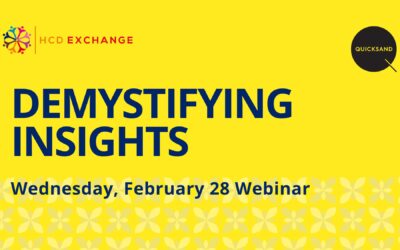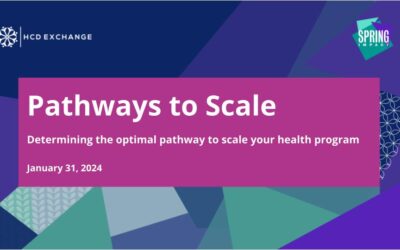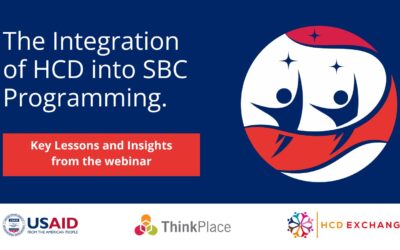On December 1, 2021, The HCDExchange Community came together for the first in a series of month-long webinars focused on sharing learnings on the use of HCD in ASRH programming.
The webinar focused on the Beyond Bias Project which sought out to challenge provider bias and ensure that youth could access non-judgmental, high-quality counseling and provision of a full range of contraceptive methods, based on their needs and circumstances. The project was delivered in Burkina Faso, Tanzania and Pakistan.
Panelists
- Dr Lydia Murithi, Beyond Bias Project Director
- Rebecca Hope, CEO of YLabs
What is provider bias?
In a Global Health: Science and Practice journal article titled Provider Bias in Family Planning Services: A Review of Its Meaning and Manifestations, Julie Solo and Mario Festin define provider bias as “attitudes and subsequent behaviors by providers that unnecessarily restrict client access and choice, often related to either client and/or contraceptive method characteristics.”
The Beyond Bias Project focused on provider bias because of the judgemental attitudes and behaviors of sexual and reproductive health service providers especially towards young people. This is usually because of their age, marital status, parity or a combination of all three factors. Because of this, care providers may provide young people with poor quality care or no care at all.
More information on the Beyond Bias Project
The Beyond Bias project is a multi-disciplinary collaboration to design and test scalable innovative solutions to address provider bias toward serving youth ages 15-24 with family planning services in Burkina Faso, Pakistan, and Tanzania. It brings together a combination of expertise in AYSRH and evidence with human-centered design, behavioral economics and segmentation and analysis.
The four organisations that came together to make it happen and their areas of expertise are:

Here are some excerpts from the conversation
On the value of HCD for Beyond Bias
Dr Rebecca Hope: One of the huge value-adds that HCD brought was rough prototyping. We were coming into a topic that is really tricky and sticky to think about. Bias is something that we don’t always want to admit to and name. There is very little data around what the drivers of bias are so we needed to start from the beginning. We got to a place where we were robustly comfortable with our understanding of bias. Every single prototype we developed mapped those drivers so we could identify the prototypes and the drivers they were aiming to address. Then we tested them carefully.
On when you need the comprehensive HCD approach and when you need a narrow application of HCD

On designing for scale
Dr Rebecca Hope: An analogy we often use in this project is the pizza analogy. The base of a pizza is like the common drivers of bias. We could design very common intervention components for those common drivers of bias across the geographies we worked in and then we could pressure test those interventions. With this, we were confident in our pizza base.
Then we had to design for provider segments so we were adding on toppings that would address the specific biases that specific segments had in different geographies. This is the analogy we used for designing for multiple geographies and designing for multiple segments.
On identifying the diverse project partners who provided a multidisciplinary approach to problem solving in the project and ensuring that the multidisciplinary approaches complemented and were accepted by each other
Dr Lydia Murithi: The problem at hand led to this multidisciplinary approach. From a scoping perspective, we were dealing with a persistent issue that was well defined and conventional approaches have not been able to address. We were mandated to disrupt the status quo on how the field responds to provider bias. HCD and segmentation analysis which were newer methodologies coming from the marketplace were included because they have a way of sparking innovation and we needed innovation.
There is a risk that you can bring all these voices together but they will sit in their little corners and not hear each other. It is hard to have these voices come together and it takes effort. We were intentional. We made sure that the development process was driven by evidence, was iterative and collaborative across partners and disciplines and we were deliberate about ensuring that the various methodologies spoke to each other. We would ask ourselves critical questions. For example, between research and design, we’d ask, “how can research findings inform solution design? How can the learnings from the HCD sessions further our understanding of how bias manifests in different countries? What can we learn from segmentation analysis and how can we apply it so we can scale the solution? Segmentation was important because bias is not monolithic.
Dr Rebecca Hope: The watch words here are:
- Mutual respect
- Curiosity
- Open mindedness
- Respecting local knowledge
On how the process of design, implementation and solution converged and diverged across countries and if there were there notable themes/insights that did or didn’t come out across the geographies
Dr Rebecca Hope: What we were trying to do was trying to understand how to design for scale. We had to use the pizza analogy here. Like the pizza base, we had to first get what was common across geographies to design anything that would scale. We had to cross validate in both the survey and qualitative interviews. For Beyond Bias, there were 11 key bias drivers so our intervention had to get at these key drivers. We also had six segments of providers who had different bias profiles so we had to get at this. This made it juicy and interesting as a project but challenging sometimes.
Dr Lydia Murithi: Another point that was critical for us to think about was the use of the ExpandNet tool which guides you on how to build with the end in mind and the resource teams needed. That’s a tool that is already accessible and available and it highlights the benefit of building from what exists.
On addressing bias related to the person implementing the HCD research
Dr Rebecca Hope: We are all biased and it’s just incredibly hard to admit that. YLabs works heavily across stigmatized and taboo topics like mental health, HIV, sexualuty, reproductive health, and so it is important to acknowledge and own that your team will be biased. We have open discussions at the beginning of research to identify the biases we have and create the space to talk about them. Name the biases and name how you will mitigate those in the research.
With HCD, synthesis is important. It’s rapid. It’s not a qualitative analysis or often isn’t a quantitative analysis. You are driving towards action and designing solutions so if you don’t make space in your approach or methodology for everyone to feel safe to contribute their ideas and thoughts, you will end up with one or two people dominating synthesis and end up with their interpretations of the data. This is where you will end up with biased findings and solutions which are not potentially going to be validated in the end.
- When doing ideation, ensure it is democratic and everyone has the space to bring their idea. Have clear criteria and score ideas together
- Name your biases
- In synthesis, make sure you are constantly asking “does this sit true? Does this make sense? Is this right?”
- Beware of the outliers. Everyone will do research and talk about the one story that was compelling and emotional but doesn’t necessarily represent the whole
Dr Lydia Murithi: I’d like to stretch this and say that it isn’t only HCD that comes with bias. All practitioners at the table come with their own biases. It requires a lot of intellectual humility and empathy to want to train yourself to hear others and see how others see things. We need to check ourselves across the board and focus on the girls in the village. It’s not about how behavioral economics is superior to HCD. It’s about how all disciplines come together to contribute.
On how the project demystified HCD and how it can be used by practitioners?
Dr Lydia Murithi: We began with the consensus that HCD provides value. However, not every project needs HCD because it costs money and resources to incorporate HCD in your programming. You will need to build capacity. You will need to teach people a new language for doing things. The approach needs to be justifiable. Pay attention to user engagement. Do you have a platform you can engage users with? If you identify that you have a gap or challenge that requires HCD, please plan for it. Fund and budget for it well and put measures and checks and balances in place to make sure it’s set to succeed.
Dr Rebecca Hope: The flavour of HCD we took for this project took a lot of expertise. It took a very experienced multi-disciplinary team, which worked well for this project. Sometimes there is the tendency to think that we can learn about HCD in a couple of workshops and go off to put it into action. In this project we had designers with 10, 15 years of experience. Capacity building was critical. I’d like to caution against the assumption that you can train teams and then send them off on their own. As a field, we need to give value to HCD as a deep area of expertise. At YLabs, we train staff for a number of years before having them run projects. In certain places we need intentional and intensive methods for unsolved large scale, tricky problems.
Resources
- Watch the full webinar here
- Access the full presentation here
- Read Beyond Bias’ three-part series on developing effective, scalable adolescent and youth sexual and reproductive health interventions using HCD here



